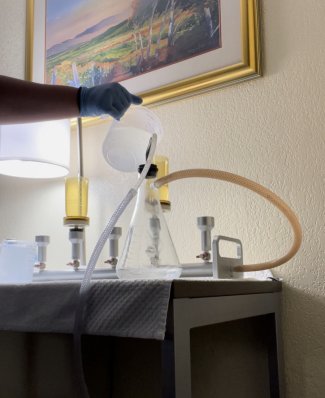In South Dakota, invasive carp (formerly known as Asian carp) have made their way into the James River, the Big Sioux River and the Missouri River below Gavins Point Dam. Physical barriers are keeping "America's most unwanted fish" from swimming farther up the Missouri River — and South Dakota officials and researchers are eager to keep it that way.
While flooding poses a potential pathway for carp to circumvent these physical barriers, human-mediated introductions — such as the release of juvenile carp via live bait — are a similar pathway of concern.
"Juvenile invasive fish may be inadvertently released by anglers, resulting in potential negative ecological, economic and social impacts," said Hannah Mulligan, a graduate research assistant in South Dakota State University's Department of Natural Resource Management.

New research from Mulligan and her colleagues was the first of its kind to explore the live bait trade in the Missouri River basin. Through environmental DNA monitoring, Mulligan found that bigheaded carp — a catch-all term for silver and bighead carp — DNA had been present in commercial bait shops throughout the region.
"The live bait trade represents a potential human-mediated, weak-link pathway for invasions," Mulligan said.
Mulligan and her colleagues conducted this study, which was published in the academic journal Biological Conservation under the title "Opportunities for regional collaboration and prevention: assessing the risk of the live bait trade as a pathway of invasive species," during the summer and fall of 2022, when they visited 112 bait retailers in North Dakota, South Dakota, Iowa, Nebraska and Kansas. The team collected water samples from each retailer and tested them for bigheaded carp DNA.
Ten water samples from 10 different bait retailers tested positive for bigheaded carp DNA in North Dakota (one positive), South Dakota (four positives), Iowa (four positives) and Kansas (one positive) during the summer collection period. The team then collected an additional 60 water samples in the fall from 30 bait retailers in South Dakota, 18 of which were resampled from the initial round of testing. Five water samples from four bait retailers tested positive for bigheaded carp DNA.
"One bait retailer tested positive for bigheaded carp during both sampling periods" Mulligan said. "Three bait retailers that had DNA during the initial sampling were negative when resampled. One bait retailer that did not have DNA during the initial sampling period had DNA during the second sampling."
Of most concern were two positive detections in bait shops outside the current known range of invasive bigheaded carp.
"Baitfish release where bigheaded carp cannot spread on their own could introduce these species beyond current barriers (such as Gavins Point Dam) and lead to establishment from only a few individuals," Mulligan said.
It should be noted that while environmental DNA of bigheaded carp was detected in the water tanks of bait retailers, no juvenile carp were observed. This is because environmental DNA monitoring can detect DNA between seven and 21 days in these systems.

"We didn't find any bigheaded carp individuals within the tank, but DNA indicates that they were somewhere within that pathway," Mulligan said. "We found no evidence of contamination in our study, and thus, the detection of bigheaded carp environmental DNA may indicate that these species were either present in the tank, passed through the tank, or baitfish harvest occurred in an area where bigheaded carp were present."
Wild harvesting is the primary way in which juvenile carp and other types of fish could end up in commercial bait shops. During the research process, Mulligan and her team found other non-advertised, and sometimes illegal species, being sold at bait shops. This exemplifies the challenges in differentiating juvenile invasive fish from legal baitfish species.
"Invasive species may remain undetected through the collection, transportation and retail sale of baitfish due to the difficulty of identifying small-bodied fish," Mulligan said.
Of course, just because bait shops may have juvenile carp in their tanks, it doesn't mean the invasive species will automatically be introduced into new waterways. Anglers also have a responsibility to be cautious with their live bait and to follow state rules and regulations.
A common misconception among anglers is that releasing live bait into waterways benefits the ecosystem. Previous research in Minnesota found that 20% of anglers release their leftover live bait at least some of the time. While well-intentioned, this is one of the ways invasive species — specifically invasive carp — can be introduced to new water bodies.
In the Mid-Atlantic region of the United States, live bait release has been attributed to the introduction of at least 29 non-native species.
In South Dakota, releasing bait is only legal if it is harvested and released in the same water body. In all other instances, releasing live bait is prohibited.
"Anglers are not only (potentially) releasing invasive fish species, but also pathogens or zebra mussel veligers that could impact native fish populations," Mulligan said.
Properly disposing of live bait is the best way to ensure invasive species or pathogens are not introduced into new waterways, Mulligan notes.
"The risk highlighted by this study illustrates the need for preventative actions, including regulations, targeted and active monitoring, and diverse educational and outreach materials near invasion fronts, to limit the risk of invasive species introductions," Mulligan said.
Mulligan's full study.
For more information on invasive carp.
- Contact:
- Telephone number: 605-688-6161
Republishing
You may republish SDSU News Center articles for free, online or in print. Questions? Contact us at sdsu.news@sdstate.edu or 605-688-6161.

